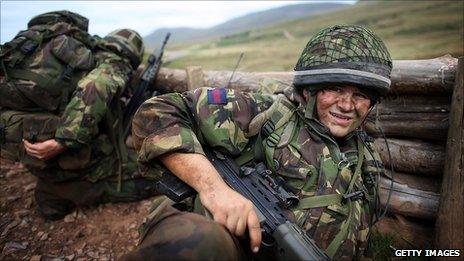Changing balance between UK reservists and regular troops
- Published
- comments

By 2020 the Territorial Army will form about 30% of a 120,000-strong army
By 2020, the aim is to produce a combined army strength of 120,000 with the reserves comprising 30% of that.
That sounds like good sense, yet the National Defence Association, external lobbying group has called today's news, "mind-bogglingly idiotic".
Patrick Mercer, Conservative MP and a former infantry battalion commander has adopted a more measured tone, but has criticised the government for doing this while troops are still so actively engaged in operations in Afghanistan.
The difference of views derives from the fact that while today emphasising new investments, the government's proposed cut to regular forces amounts to around 20% of the army, around 18,000 troops, and comes at a time when so many soldiers are still risking their lives on operations.
While many had hoped that changing the ratio of reserve to regular forces might be achieved by boosting the numbers and roles of the part timers, the same result will actually be achieved by cutting the regular army!
There are plans to invest £1.5bn in the reserves, but as this will take 10 years to happen, the actual investment of £150m each year seems small in overall defence terms.
Some of the grand designs for the reserves, for example sketched out in a previous paper by Lieutenant General Sir Graeme Lamb who was one of those who advised the defence secretary on today's announcement, cannot be done for this sum.
Balancing books
Lt Gen Lamb and others had pointed to the fact that some other countries like the US keep a large proportion of their capabilities for a major war in the reserves. What could be more logical, for example, than putting much of your 'heavy metal' - the tanks and self propelled artillery not needed in counter insurgency missions - in the reserves?
The UK though has not for decades made the kind of investment in reserve forces that would allow the creation of reserve tank regiments or squadrons of fighter planes. Countries like the US or Israel, by contrast do, and can gear up their military effort greatly in time of war as a result.
So today's announcement strikes many as using a moderate investment in the reserves (and some other equipment projects for regular forces) to distract form deep cuts elsewhere. While the defence secretary also itemised cuts to support services, it is clear that cutting the army's numbers substantially is one of the few ways that the Ministry of Defence can possibly balance its books.
Talking to a former general from the Rifles, he expresses concerns that his regiment, currently consisting of five regular and two reserve battalions, will see at least one regular battalion cut as the drawdown from Afghanistan begins.
In Sangin during 2009-10 two battalions from the Rifles suffered the sad distinction of suffering the highest casualties of any British units that have served in Helmand. It is the contrast between this hard service, and the expectation of further cuts that leaves so many in the army upset by current policies.
Dark rumours meanwhile swirl about Whitehall about the extent of further cuts that might be necessary to balance the MoD's programmes. There are references to a Royal Navy with only 12 frigates and destroyers or an RAF with just 80 combat aircraft.
It is little wonder that there is a great deal of emotion around. David Davis has opined that the UK is no longer a major military power and should stop pretending that it is. While another senior Tory, Bernard Jenkin, argued in a report published today that the UK has reached a, "tipping point" in terms of its world role.